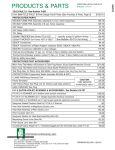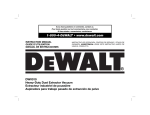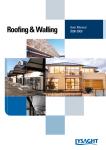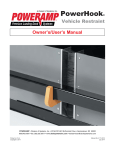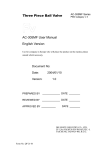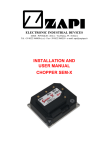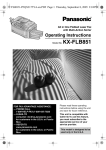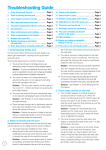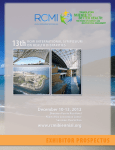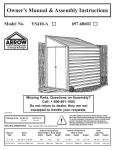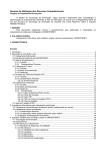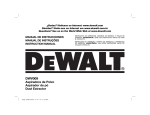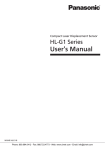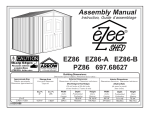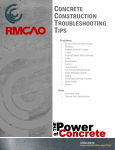Download ADDENDUM NO. 4 - Indianapolis International Airport
Transcript
ADDENDUM NO. 4 November 16, 2009 Indianapolis International Airport Indianapolis, Indiana Belly Cargo/GSE Maintenance Building IAA Project No. I-09-033-B Contents: Addendum No. 4 Text, Pages 1 through 22 Attachments: Technical Provisions Table of Contents Section 04100 - Mortar, pages 1-4 Section 04150 – Masonry Reinforcement and Accessories, pages 1-2 Section 04210 – Concrete Masonry, pages 1-6 Section 17139 – Cable Trays, pages 1-6 Section 17710 – Telephone System, pages 1-8 Plan Sheets – Base Bid G105A – Safety and Phasing Plan East SIDA Gate, dated 11/16/09 C111A – Existing Conditions Plan, dated 11/16/09 C302 – Fire Service Line Plan and Profile Line ‘FS-1’, dated 11/16/09 C304 – Fire Service Line Plan and Profile Line ‘FS-4’, dated 11/16/09 C305 – Waterline Details, dated 11/16/09 E101 – Electrical Site Plan, dated 11/16/09 SS000 – Security Legends and Abbreviations, dated 11/16/09 SS100 – Security and Telecom Systems Floor Plan, Area A, dated 11/16/09 SS101 – Security and Telecom Systems Floor Plan, Area B, dated 11/16/09 SS301 – Security Enlarged I.T. Room 510 Layout, dated 11/16/09 SS401 – Security Structured Cabling Block Diagram, dated 11/16/09 SS608 – Telecom Junction Box Details, dated 11/16/09 Addendum No. 4 Indianapolis International Airport Belly Cargo/GSE Maintenance Building November 16, 2009 Page 2 of 22 Plan Sheets – Additive Bid SS100A – I.T. and Telecom Systems Floor Plan – Area A, dated 11/16/09 SS101A – I.T. and Telecom Systems Floor Plan – Area B, dated 11/16/09 SS301 – Security Enlarged I.T. Room 510 Layout, dated 11/16/09 SS401A – Security Structured Cabling Block Diagram, dated 11/16/09 SS404 A – Telephone Cable Block Diagram, dated 11/16/09 SS608A – I.T. Junction Box Details, dated 11/16/09 AOC/EOC Plant Precast Architectural Concrete Design Mix Addendum No. 4 Indianapolis International Airport Belly Cargo/GSE Maintenance Building November 16, 2009 Page 3 of 22 TO: All Planholders of Record The following addendum items modify, change, delete from or add to, the requirements of the contract documents for this project. The articles contained in the addendum take precedence over the requirements of the previously published contract documents. Where any article of the contract specifications or any detail of the contract drawings is modified or any paragraph, subparagraph or clause thereof is modified or deleted by the articles contained in this addendum, the unaltered provisions of that article, paragraph, subparagraph or clause shall remain in effect. ITEM NO. 1 SPECIFICATIONS VOLUME 1 OF 2 Invitation to Bidders, Page INV-1 Delete: First bullet. Insert: Revised first bullet as follows: • Sealed bids will be received by the Indianapolis Airport Authority, Indianapolis, Indiana, for the Indianapolis International Airport, Belly Cargo/GSE Maintenance Building, Project No. I-09-033-B, in Conference Room 3 at the Program Office, 2349 Aviation Drive, Indianapolis, Indiana 46241 on Tuesday, November 24, 2009, at 10:00 a.m. local time. All bids will be opened at a public meeting and read aloud. Any bids received after the designated time will be returned unopened. Bids are desired as set forth in the Instructions to Bidders, which is part of the specifications. General Provision GP 70-11 Insurance, Insurance (Liability) Delete: Bullet labeled “Statutory Workers’ Compensation and Employers Liability. Insert: Revised bullet as follows: • Statutory Workers’ Compensation and Employers Liability. The coverage will provide employers liability insurance with limits of not less than the following: Bodily Injury by Accident Bodily Injury by Disease Bodily Injury by Disease $1,000,000 Each Accident $1,000,000 Each Employee $1,000,000 Policy Limit Workers’ compensation insurance will provide a waiver of subrogation in favor of Indianapolis Airport Authority and their respective officers, directors, employees, and agents. Addendum No. 4 Indianapolis International Airport Belly Cargo/GSE Maintenance Building November 16, 2009 Page 4 of 22 Special Provision SP-25 Water Valve/Meter Vault Delete: SP-25 issued with bid documents. Insert: Revised SP-25 as follows: The water valve/meter vault shall be installed as shown on the plans. The vault shall be as detailed on Sheet C305 of the plans and shall include accommodation for two 1” meters. The water meters will be provided and installed by the Indianapolis Water Company. All other components shown shall be provided and installed by the Contractor. ITEM NO. 2 SPECIFICATIONS VOLUME 2 OF 2, TECHNICAL PROVISIONS Table of Contents Delete: Table of Contents issued with bid documents. Insert: Revised Table of Contents, dated 11/16/09 (attached). Section 03450 – Plant Precast Architectural Concrete Delete: Paragraph 1.04.A.6. Insert: Revised Paragraph 1.04.A.6. as follows: Color and finish to match adjacent AOC/EOC facility. Copy of design mix used for AOC/EOC facility is attached. Section 04100 – Mortar Insert: New Section 04100, dated 11/16/09 (attached). Section 04150 – Masonry Reinforcement and Accessories Insert: New Section 04150, dated 11/16/09 (attached). Section 04210 – Concrete Masonry Insert: New Section 04210, dated 11/16/09 (attached). Section 06410 – Interior Architectural Woodwork Delete: Paragraph 2.01.A in its entirety. Insert: Revised Paragraph 2.01.A as follows: A. Available Fabricators: Subject to compliance with requirements, fabricators offering interior architectural woodwork that may be Addendum No. 4 Indianapolis International Airport Belly Cargo/GSE Maintenance Building November 16, 2009 Page 5 of 22 incorporated into the Work include, but are not limited to, the following: 1. 2. 3. 4. Alex Wilson Carpentry Fischer Woodcraft, Inc. Wood Craft Husers Laminates & Custom Woodworking Section 16130 – Raceway and Boxes for Electrical Systems Delete: Paragraph 3.1.B.1. Insert: Revised Paragraph 3.1.B.1 as follows: Exposed for locations below 12’-0” above finished floor are considered subject to severe physical damage: RGS. Delete: Insert: Paragraph 3.1.B.2. Revised Paragraph 3.1.B.2 as follows: Exposed for locations above 12’-0” above finished floor are not considered subject to severe physical damage: EMT. Delete: Paragraph 3.1.B.3 and subparagraphs. Insert: Revised Paragraph 3.1.B.3 as follows: Exposed in Mechanical Areas: RGS. Section 17139 – Cable Trays Insert: New Section 17139, dated 11/16/09 (attached). Section 17710 – Telephone System Delete: Section 17710 – Telephone System, dated 10/30/09, issued as part of Addendum No. 1. Insert: Revised Section 17710 – Telephone System, attached. Section 17742 – Structured Cabling Systems Delete: Paragraph 2.1.A.2. Fiber Optic. Insert: Revised Paragraph 2.1.A.2. as follows: Addendum No. 4 Indianapolis International Airport Belly Cargo/GSE Maintenance Building November 16, 2009 Page 6 of 22 2. Fiber Optic: AMP Avaya Belden Berk-Tek CommScope Corning OCC Mohawk/CDT NORDX/CDT Panduit Siecor Superior Essex Delete : Paragraph 2.2.D.1. Coaxial Cable Insert: Revised Paragraph 2.2.D.1 as follows: 1. General: Coaxial cables shall be plenum rated. All coaxial cable shall be 75-ohm type RG-6 with an 18 AWG solid copper center conductor, Foam FEP dielectric, and a copper braided shield providing at least 85% coverage unless otherwise noted. The outer jacket shall be UV rated when installed outdoors with exposure to sunlight. Connectors for this cable shall be of the type approved by the connector manufacturer for this particular cable and shall not be of the screw-on variety. The tool utilized to crimp on the connector shall be of the type approved by the connector manufacturer. ITEM NO. 3 PLAN SHEETS – BASE BID PLAN SHEET G105A – SAFETY AND PHASING PLAN EAST SIDA GATE Insert: New Plan Sheet G105A, dated 11/16/09 (attached). PLAN SHEET G107 – SITE WORK SCHEDULE OF VALUES Delete: Item No. 11, Qty. column, delete “115”. Insert: Item No. 11, Qty. column, add “160”. Delete: Item No. 12, Qty. column, delete “40”. Insert: Item No. 12, Qty. column, add “60”. Delete: Item No. 13, Qty. column, delete “90”. Insert: Item No. 13, Qty. column, add “725”. Addendum No. 4 Indianapolis International Airport Belly Cargo/GSE Maintenance Building November 16, 2009 Page 7 of 22 Delete: Item No. 14, Qty. column, delete “270”. Insert: Item No. 14, Qty. column, add “0”. Delete: Item No. 15, Qty. column, delete “110”. Insert: Item No. 15, Qty. column, add “0”. Delete: Item No. 16, Qty. column, delete “460”. Insert: Item No. 16, Qty. column, add “0”. Delete: Item No. 24, Qty. column, delete “135”. Insert: Item No. 24, Qty. column, add “180”. Delete: Item No. 26, Qty. column, delete “8”. Insert: Item No. 26, Qty. column, add “5”. Insert: New Item No. 77 as follows: Item No. Spec. Description 77 U-100 Post Indicator Valve, 6 inch Qty. Unit 1 Ea PLAN SHEET C111A – EXISTING CONDITIONS PLAN Insert: New Plan Sheet C111A, dated 11/16/09 (attached). PLAN SHEET C302 – FIRE SERVICE LINE PLAN AND PROFILE LINE ‘FS-1’ Delete: Plan Sheet C302, issued 10/16/09. Insert: Plan Sheet C302, revised 11/16/09 (attached). (Revised routing of fire service line). PLAN SHEET C304 – FIRE SERVICE LINE PLAN AND PROFILE LINE ‘FS-4’ Delete: Plan Sheet C304, issued 10/16/09. Insert: Plan Sheet C304, revised 11/16/09 (attached). (Revised routing of fire service line, deleted two valves). Addendum No. 4 Indianapolis International Airport Belly Cargo/GSE Maintenance Building November 16, 2009 Page 8 of 22 PLAN SHEET C305 – WATERLINE DETAILS Delete: Plan Sheet C305, issued 10/16/09. Insert: Plan Sheet C305, revised 11/16/09 (attached). (Revised meter vault to remove double check assembly, fire department connection, and post indicator valve; revised Pump Connection and Fire Hydrant Details to add post indicator valve and enlarge concrete slab). PLAN SHEET C402 – TRASH CORRAL DETAILS – FRONT ELEVATION Delete: Leader pointing to gate leaf reading “CONTRACTOR TO PROVIDE 100% OPAQUE PRIVACY SLATS. CONTRACTOR SHALL SUBMIT COLOR SAMPLES FOR APPROVAL”. Insert: Leader pointing to gate leaf reading “CONTRACTOR TO PROVIDE MIN. 75% OPAQUE PRIVACY SLATS. CONTRACTOR SHALL SUBMIT COLOR SAMPLES FOR APPROVAL”. PLAN SHEET M401 – MECHANICAL SCHEDULES Delete: In Exhaust Fan Schedule, Mark EF-1, ESP column, delete ‘.150’. Insert: In Exhaust Fan Schedule, Mark EF-1, ESP column, add ‘0.375” WC’. Delete: In Exhaust Fan Schedule, Mark EF-2, ESP column, delete ‘.125’. Insert: In Exhaust Fan Schedule, Mark EF-2, ESP column, add ‘0.375” WC’. Delete: In Exhaust Fan Schedule, Mark EF-3, ESP column, delete ‘.150’. Insert: In Exhaust Fan Schedule, Mark EF-3, ESP column, add ‘0.375” WC’. Delete: In Exhaust Fan Schedule, Mark EF-4, ESP column, delete ‘.150’. Insert: In Exhaust Fan Schedule, Mark EF-4, ESP column, add ‘0.375” WC’. PLAN SHEET P101 – PLUMBING AND FIRE PROTECTION FLOOR PLAN Delete: Plan Note 3 reading ‘3” DRAIN’. Insert: Revised Plan Note 3 reading ‘3” DRAIN. DRAIN SHALL BE J. R. SMITH MODEL #2120-M, DUCTILE IRON STRAINER. PLUMBING CONTRACTOR SHALL PROVIDE P-TRAP. DRAIN IN ALL SUITES INCLUDING SUITE #306’. Addendum No. 4 Indianapolis International Airport Belly Cargo/GSE Maintenance Building November 16, 2009 Page 9 of 22 PLAN SHEET P401 – PLUMBING SCHEDULES Insert: In Plumbing Fixture Schedule, Mark L1H, Remarks column, add “PROVIDE LAVATORY WITH MIXING VALVE, LAWLER TMM-1000”. Insert: In Plumbing Fixture Schedule, Mark SK1, Remarks column, add “PROVIDE SINK AND MIXING VALVE, LAWLER MM-1000”. Delete: In Plumbing Fixture Schedule, Mark WTS1, Manufacturer and Model column, delete “LOWLER #66-150-83006”. Insert: In Plumbing Fixture Schedule, Mark WTS1, Manufacturer and Model column, add “LAWLER 911E. FOR EYE WASH SHOWER.” PLAN SHEET E101 – ELECTRICAL SITE PLAN Delete: Plan Sheet E101 dated 10/16/09. Insert: Plan Sheet E101 revised 11/16/09, attached. (Revised extent of conduit concrete encasement). PLAN SHEET SS000 – SECURITY LEGENDS AND ABBREVIATIONS Delete: Plan Sheet SS000 dated 10/16/09. Insert: Plan Sheet SS000 revised 11/16/09, attached. (Revised structured cabling legend). PLAN SHEET SS100 – SECURITY AND TELECOM SYSTEMS FLOOR PLAN – AREA A Delete: Plan Sheet SS100 dated 10/27/09. Insert: Plan Sheet SS100 revised 11/16/09, attached. (Revised entire sheet). PLAN SHEET SS101– SECURITY AND TELECOM SYSTEMS FLOOR PLAN – AREA B Delete: Plan Sheet SS101 dated 10/27/09. Insert: Plan Sheet SS101 revised 11/16/09, attached. (Revised entire sheet). Addendum No. 4 Indianapolis International Airport Belly Cargo/GSE Maintenance Building November 16, 2009 Page 10 of 22 PLAN SHEET SS301– SECURITY ENLARGED I.T. ROOM 510 LAYOUT Delete: Plan Sheet SS301 dated 10/27/09. Insert: Plan Sheet SS301 revised 11/16/09, attached. (Revised entire sheet). PLAN SHEET SS401– SECURITY STRUCTURED CABLING BLOCK DIAGRAM Delete: Plan Sheet SS401 dated 10/27/09. Insert: Plan Sheet SS401 revised 11/16/09, attached. (Revised entire sheet). PLAN SHEET SS608 – TELECOM JUNCTION BOX DETAILS Insert: New Plan Sheet SS608, dated 11/16/09 (attached). ITEM NO. 4 PLAN SHEETS – ADDITIVE BID PLAN SHEET SS100A – I.T. AND TELECOM SYSTEMS FLOOR PLAN – AREA A Delete: Plan Sheet SS100A dated 10/27/09. Insert: Plan Sheet SS100A, dated 11/16/09 (attached). (Revised entire sheet). PLAN SHEET SS101A – I.T. AND TELECOM SYSTEMS FLOOR PLAN – AREA B Delete: Plan Sheet SS101A dated 10/27/09. Insert: Plan Sheet SS101A, dated 11/16/09 (attached). (Revised entire sheet). PLAN SHEET SS401A – SECURITY STRUCTURED CABLING BLOCK DIAGRAM Insert: New Plan Sheet SS401A, dated 11/16/09 (attached). PLAN SHEET SS404A – TELEPHONE CABLING BLOCK DIAGRAM Delete: Plan Sheet SS404A dated 10/27/09. Insert: Plan Sheet SS404A, dated 11/16/09 (attached). Addendum No. 4 Indianapolis International Airport Belly Cargo/GSE Maintenance Building November 16, 2009 Page 11 of 22 (Revised telephone cabling block diagram and Cat6 cables). PLAN SHEET SS608A – I.T. JUNCTION BOX DETAILS Delete: Plan Sheet SS608A dated 10/27/09. Insert: Plan Sheet SS608A, dated 11/16/09 (attached). (Removed Detail B). ITEM NO. 5 BIDDER QUESTIONS Question 36: Please confirm that a self-propelled truck type vacuum sweeper must be on site at all times. Answer 36: Confirmed Question 37: Please confirm that all open trenches are to be flagged and lighted at night. Answer 37: Open trenches within Runway Safety Areas and Taxiway Safety Areas must be flagged and lighted at night. See plan sheet G106. Question 38: Is the Engineer’s field office and furniture per Item M-101 required for this project? Answer 38: Yes. Question 39: Is the work shown for the “Upgrades to the East SIDA Guardhouse Project B-11” to be included in our bid for the Belly Cargo/GSE Maintenance Building? Answer 39: Yes, see Pre-Bid Meeting Summary contained in Addendum No. 1. Question 40: Please confirm that all soils under pavement are to be lime stabilized per INDOT Specification 215 by this project. Answer 40: See Special Provision SP-27. Question 41: [Technical] Specification Section 06410 lists 5 approved fabricators that are located in Florida. Can some local fabricators be added to this list? Answer 41: See Item No. 2 Specifications Volume 2 of 2, Technical Provisions in this addendum. Question 42: Please confirm whether or not a P.E. stamped structural engineering analysis is required for the sectional doors and overhead coiling grills. Answer 42: No, not required. Addendum No. 4 Indianapolis International Airport Belly Cargo/GSE Maintenance Building November 16, 2009 Page 12 of 22 Question 43: The following [6] questions all have to do with the design and pricing of the preengineered metal building structure. What is the uniform collateral load to be designed for the roof structure (frames and bar joists/roof purlins) in (PSF)? Answer 43: The collateral load of the roof structure is dependent on the pre-engineered building manufacturer. The uplift requirements for the roof are 90 MPH and increased to 120 MPH up to 12’-0” from each corner of the building. Question 44: Are there any point loads that need to be designed into the roof structure for any mechanical or electrical devices? If so, provide the weight and exact location of each point load. Answer 44: All loading applied to the roof is to be coordinated with the MEP and security contractor. This includes, but is not limited to: sprinkler loads and penetrations, exhaust fans loads and penetrations, and duct work. Question 45: Are all the openings in the walls, windows and overhead doors, designed to withstand 90 mph winds? If so, then this building is classified as a “fully enclosed structure”. If they are not, then this building is classified as a “partially enclosed structure”. This classification affects the wind up-lift design of the roof structure. Which classification does the PEMB need to be design and price as? Answer 45: Yes, the openings in the wall, windows, and doors should be designed to withstand wind loads. Question 46: Sheet A111 shows a specific amount of roof penetrations: 6 ea.: 12 x 12 x 164 curbs and 47 ea. vent flashings. Is PEMB manufacturer to assume this is the correct total of roof penetrations? If there ends up being more, does the Owner pay for them? Answer 46: Sheet A111 shows more than 6 roof penetrations. The total number of roof penetrations will be determined by the General Contractor, and coordinated with other trades. No, the Owner does not pay for other penetrations that are required by MEP trades. Question 47: The specifications call for the roof panels to be Silver Metallic SR by Kynar finish. This is a custom color to most if not all PEMB mfg’s. Is this the color that must be provided? Answer 47: Yes. Question 48: If the answer to #5 [#47] is yes, then are the gutters and downspouts to be this same Silver Metallic SR color? Or will they be selected from the mfg’s standard colors? Answer 48: Yes, same color as roof panels. Addendum No. 4 Indianapolis International Airport Belly Cargo/GSE Maintenance Building November 16, 2009 Page 13 of 22 Question 49: Is the structural drawings reflecting the framing of the roof using joint and purlins the only method of roof framing or is it up to the PEMB designer to simply meet the design criteria, even if alternate framing design can be utilized? Answer 49: PEMB designer to meet the design criteria. Alternate framing design may be utilized and must be coordinated with the precast manufacturer and other trades. Question 50: Addendum #1 changed the amount of work that can be subcontracted out as 85%. So all bidders are clear, is the 15% by the general contractor to be by selfperformed labor or a dollar value which could include material purchases for work performed by subcontractors? Answer 50: 15% must be self-performed by the General Contractor. Question 51: Is there or is there not Liquidated Damages and/or penalty clause, if the contractor fails to complete construction in the 180 calendar days? Answer 51: There are no Liquidated Damages. Question 52: Is it correct that the Notice to Proceed will not be issued until permits are in hand? Answer 52: See Addendum No. 1, Item No. 4 Specifications Volume 1 of 2, Special Provision SP-30 Permits and Licenses. Question 53: Are we to include, in our proposal, any chemical modified soil, as on the drawings? Or was this included as part of the Sitework package? Answer 53: See Addendum No. 2, answer to Question 26, and Special Provision SP-27. Question 54: Are we to supply “Knox Box” key holders? If so, is one required at each tenant space? Answer 54: Yes, Plan Sheet A104, see Plan Note 14. Question 55: The structure details show three different thickness of concrete foundation walls along the north side of the building. Can one thickness of concrete wall be used and what thickness would that be? Answer 55: See Addendum No. 2, answer to Question 22. Question 56: Sheet S400 says that 3000 psi concrete is to be used everywhere. Specification section 03300 says that 4000 psi concrete is to be used everywhere. Please clarify which concrete is to be used. Answer 56: 4,000 psi, per Technical Provision Section 03300. Addendum No. 4 Indianapolis International Airport Belly Cargo/GSE Maintenance Building November 16, 2009 Page 14 of 22 Question 57: Section 0813, 1.04 B 3 – Indicates field wiring by Division 16 Drawing E-202 Indicates Disconnects and Wiring by Division 8, please clarify. Answer 57: The General Contractor coordinates all trades. Question 58: Drawing A-300 Clearly show track above 13’, spec 08131 2.06D Specifies Standard Lift. Standard Lift would be less than 11’. Please clarify. Answer 58: Elevation D5, 10’x10’ doors to be high lift to 13’ A.F.F. All other sectional doors to be standard lift. Question 59: 08313, 2.06 J Specifies a Jackshaft type operator, while doors are specified standard lift. Is a trolley operator acceptable on the standard lift doors? Answer 59: Trolley operators are acceptable on standard lift doors. Question 60: 08313, 2.04 D. Cable safety devices are not designed for Standard Lift Track, Please clarify. Answer 60: Cable safety devices not required on standard lift doors. Question 61: 08313, 2.05 G. 1. Specifies Key operated Controls, they are not indicated on the Electrical drawings. Please Clarify Answer 61: Delete exterior key operated controls. Question 62: 08313, 2.06 Basis of Design is a 592 Series Overhead Door Company, the metal thickness described in 2.06 C. 2. is not consistent with this product. Answer 62: Delete 0.028 thickness for this project. Question 63: 08313, 2.05 F. specifies a Fail-Safe 4 wire edge. 2.06 J. 5. specifies a Pneumatic edge. Please Clarify. Answer 63: Delete the pneumatic edge. Question 64: 08313, 2.03 C. Specifies 2“ or 3” Rollers. 2” is standard duty, 3” is heavy duty. What is the specified track size? Answer 64: Provide the 3” heavy duty rollers and track. Question 65: Overhead Door Buttons are specified installed in Master Control Panels Division 11 at the 10 Dock Doors. Who provides these Buttons? Answer 65: The General Contractor coordinates all trades. Addendum No. 4 Indianapolis International Airport Belly Cargo/GSE Maintenance Building November 16, 2009 Page 15 of 22 Question 66: There is no indication of interlocking the levelers/doors electrically to eliminate door damage. Will these interlocks be required, and will they be wired in Division 8 or 11? Answer 66: The General Contractor coordinates all trades. Question 67: 08313, 2.01 Is expanded polystyrene insulation acceptable with an R value of 10.25 providing the door is still of composite type construction? Answer 67: Yes. Question 68: Drawing E-202 States that the Disconnects and all wiring from the disconnects to the equipment are by Division 11. Will this language be added to Spec 11160? Answer 68: The General Contractor coordinates all trades. Technical specification 11160 will not be revised. Question 69: 11160, 1.08 a. Is the Equipment contractor to include these four PM’s in the base bid? Or simply propose it for execution by owner after occupying facility? Answer 69: Include in Base Bid. Question 70: 11160, 2.02 E. The specification calls out an 80K ramp with a 3/8” deck plate then under 202E calls for a ½” lip plate which is extremely light for this capacity. A 1” thick lip plate would be typical to comply with the Specified Rated Capacity. Please advise. Answer 70: Provide a 1” thick lip plate. Question 71: 11160, 2.02 F. 4a The lip should be 18” in lieu of 16” to provide adequate lip purchase beyond the recommended bumper projections. Answer 71: Provide 18” lip. Question 72: 11160 2.02 F. A “Barrier Lip” option can be added to prevent accidental “run-off” of the fork truck from the dock in both the level and below dock end-load position. The specification does not mention this. Is this option required? Answer 72: Provide a “Barrier Lip”, Model BL-2, Power Ramp Systems, Inc. Question 73: Section 11160, 2.02 F 6 Keyed overrides should be utilized to bypass the restraints at the dockmaster’s discretion when Rear Impact Guard (RIG) bars cannot be engaged and “over ride” is required to maximize control and safety at the dock. Will they be required? Answer 73: Yes. Addendum No. 4 Indianapolis International Airport Belly Cargo/GSE Maintenance Building November 16, 2009 Page 16 of 22 Question 74: Drawing E 501 Indicates Side by Side Panels. Spec Section 11160, 2.02 F6 specifies an Integrated Panel. There is not adequate space for side by side panels and door controls. An integrated master panel should be required. Please confirm this is the case. Answer 74: Yes, provide an integrated master panel. The integrated control panel will contain a disconnect for the dock leveler and restraint systems Question 75: 2.02 F 6 Integrated panel does not specifically require power and control of guide lights and electrical detail shows no other provision. Should these be included in the master panel? Specification and electrical details do not show fused branch circuit protection for the dock equipment nor separately for the door. Should a disconnect for the dock equipment and doors be included in the control panel and should this disconnect be fused with lock out tag out capability? Answer 75: Provide an integrated control panel that includes dock restraint, dock leveler overhead door controls and exterior guide lights. Also control to have service disconnect for dock leveler and restraint system. If disconnect cannot be integrated, a separate disconnect may be provided. Question 76: 11160, 2.02 G Specification seems conflicted between a mechanical and hydraulic system. Assuming Hydraulic is preferred, “Mechanical Operating System:” and everything after “Hydraulic Control” in first paragraph should be stricken. Items 1 & 2 are OK. Please clarify. Answer 76: Either system is acceptable. Question 77: 11160, 2.02 J Hot Dip Galvanize should read “after fabrication” Will the entire Tubular Frame below the dock (2 A/301) require Hot Dip galvanizing? (recommended) Additionally, 2.09 Steel Finishes, initially indicates steel finishes are Hot-Dip Galvanized, then indicates painted. Is the leveler and it’s frame members galvanized or painted. This is not recommended to paint over Hot Dipped Galvanized. Alternatively can a spray on galvanizing finish be acceptable? Answer 77: Yes, hot dip galvanizing after fabrication for leveler and frames. spray on galvanizing is not acceptable. Painting or Question 78: 11160, 203 A specifies a 2200 series shelter but does not indicate the size. The standard size for this model is 12’0” wide x 11’6” high x 22” projection. Will this be sufficient? Answer 78: Yes, to fit around the 10’x10’ door. Addendum No. 4 Indianapolis International Airport Belly Cargo/GSE Maintenance Building November 16, 2009 Page 17 of 22 Question 79: 11160, 2.04 A Specifies a KS 7 restraint but should also state the restraint should be a recesses style restraint integrated into a 44” high “free standing frame if it is to coordinate with architectural details provided in the drawings. Confirm “PowerHook” type restraint is required. Omit “Box Form” in Item C 1 of same section. Answer 79: Restraint to be a recessed style, into a 44” high free standing frame. ‘Power Hook’ type restraint is required. Question 80: 11160, 2.04 B “Single Source Hydraulics” is the description of the Leveler and restraint, not Centrapower. Building layout would not permit economical layout of CentaPower system. Instead each leveler and restraint shall be controlled by a single power unit rather than multiple power sources. Please confirm. Answer 80: Yes, provide ‘Single Source Hydraulics’ for the leveler and restraint. Question 81: 11160, 2.05 B 1. Thickness should be 6” to protect lip from damage on this capacity of leveler. Answer 81: Yes. Question 82: 11160 2.06 A-D Is this light powered and controlled from Master panel? Answer 82: No. Question 83: 11160 2.07 A-D Are these lights powered and controlled from Master panel? Answer 83: Yes. Question 84: 11160, 1.04 C 1. Requires wheel chocks. These would be used when engagement to the ICC bar is restricted or not possible. Please provide a specification for this product. Answer 84: Provide laminated wheel chocks with 15’ chain and storage cradle. Question 85: 03300-6 Paragraph 2.07 Vapor Retarders. Will materials approved for the under-slab vapor retarder have to demonstrate they meet the permeance as specified (0.012 perms or lower) after mandatory conditioning per the requirements of ASTM E1745 Paragraphs 7.1.1 – 7.1.5? Please review the requirements of ASTM E1745 included with this question. In short, this is intended to ensure the product does not deteriorate under the slab Answer 85: Vapor retarder shall meet all requirements of Technical Provision Section 03300. Question 86: The details and the specifications for the architectural chain link fence appear to be a mixture of chain link fence details & specs and wire mesh partition details & specs. Can you please clarify which system is required for this project. Answer 86: See Addendum No. 2, answer to Question 6. Addendum No. 4 Indianapolis International Airport Belly Cargo/GSE Maintenance Building November 16, 2009 Page 18 of 22 Question 87: Per sheet C402, there are to be 100% Opaque privacy slats installed in the trash corral gates. Per a local fence contractor these do not exist. Please clarify what is needed at these gates. Answer 87: See Item No. 3 Plan Sheet – Base Bid in this addendum. Question 88: Sheet C402 shows a Masonry Dumpster enclosure. There are no masonry specifications in the bid documents. Can these please be issued by Addendum? Answer 88: See Item No. 2 Specifications Volume 2 of 2, Technical Provisions in this addendum. Question 89: 08340 Who is responsible for all wiring of these doors From disconnect to the control panel and components? Answer 89: The General Contractor coordinates all trades. Question 90: 08332. Who is responsible for providing the 460, 3 ph Disconnect? Answer 90: The General Contractor coordinates all trades. Question 91: 08332 Who is responsible for wiring from the disconnect to the motor and components? Answer 91: The General Contractor coordinates all trades. Question 92: 08332 2.02 B Indicates Hot Dip Galvanized Frame, Drawing A-404 Detail FD18 Illustrates 3/8” Bent Plate Jamb. May this be changed to ¼” Hot Dipped Galvanized Jamb? Answer 92: Yes, may be changed to ¼” hot dipped galvanized jamb. Question 93: 08332, 2.06 D Specifies Stainless Steel Guides with Wool Pile. This is only available in Aluminum Extrusions, Please Clarify Answer 93: Provide aluminum extrusion guides. Question 94: 08332, 2.06 G 3. Is this a Indication of a NEMA 4 Requirement for this operator? (2.05 A. 2 specifies NEMA ICS 1) Please clarify Answer 94: Provide NEMA 1. Question 95: 08313, Drawings Indicate “Lexan Window Typical” Please provide a specification, ie; are the windows Insulated? Is Plexiglass (Acrylic) acceptable? Answer 95: Windows are insulated type. Yes, Plexiglass (acrylic windows) are acceptable if insulated. Addendum No. 4 Indianapolis International Airport Belly Cargo/GSE Maintenance Building November 16, 2009 Page 19 of 22 Question 96: In Section 08340 – High-Speed Rolling Doors; line items 1.02,A,2,a and 2.05,2 indicates that a “web based access control system” is included in this specification section. Is this correct; is the door supplier to supply this system and, if so, can you please provide more detail on what it is? Answer 96: No, do not supply web based access control system. Question 97: In Section 08340 – High-Speed Rolling Doors; line item 2.02, D calls for a “completely enclosed barrel and operator cover” on the doors. These are interior doors which negates the need for covers in most cases. Are barrel and operator covers required on these doors? Answer 97: Yes. Question 98: In Section 08340 – High-Speed Rolling Doors; line item 2.052,C,1,b calls for a “hand-operated lockable blade-type” electrical disconnect to be provided with the doors. Does this disconnect need to be integrated into the door control panel as one unit (mounted on the door control panel) or can it be a separate, stand-alone unit? Answer 98: Provide as separate standalone unit. Question 99: In Section 08340 – High-Speed Rolling Doors, there are several references to components that will work in conjunction with induction floor loops but no direct reference to the requirement of providing induction floor loops with the doors. Are induction floor loops required for activation of the doors? Answer 99: No, activation with card reader system. Question 100: The building appears to be sprinkled but no Tampers or Flows are indicated on the drawings, please confirm no Tampers or Flow devices are required. Answer 100: See Addendum No. 2, Item No. 3 Plan Sheets – Base Bid, Plan Sheets FA100 and FA101. Question 101: Section 16721 – 2.2c Duct Detector – Please confirm no duct detectors are required for this project; the specifications appear to call for them but none shown on the drawings, please confirm? Answer 101: See Addendum No. 2, Item No. 3 Plan Sheets – Base Bid, Plan Sheets FA100 and FA101. Duct detectors are required. Question 102: Is the new fire alarm panel required to monitor the motorized dampers shown on sheets M101 thru M302, please confirm? Answer 102: Yes, see Addendum No. 2, Item No. 3 Plan Sheets – Base Bid, Plan Sheets FA100 and FA101. Addendum No. 4 Indianapolis International Airport Belly Cargo/GSE Maintenance Building November 16, 2009 Page 20 of 22 Question 103: Outside of the Access Control system is the new fire alarm panel required to interface with any other systems, please confirm? Answer 103: See Addendum No. 2, Item No. 2 Specifications Volume 2 of 2, Technical Provisions Section 16721 – Fire Alarm Systems, Paragraph 2.6.K. Question 104: Section 16721 – Fire Alarm. Is the new fire alarm panel to interface with the existing EST3 panel in the terminal. Answer 104: Yes, these panels shall communicate with each other too. See Addendum No. 2, Item No. 2 Specifications Volume 2 of 2, Technical Provisions, Section 16721 – Fire Alarm Panels. Paragraph 2.7 was deleted. Question 105: Section 16721 2.7 Remote Annunciator. Please confirm if a remote annunciator is required for this job; called out in the specifications but no shown on drawings? Answer 105: Remote Annunciator was removed from specs in Addendum No. 2. Question 106: Sheet FA101 – Please clarify what the “H” and “J” in room 1204 (repair area) are to represent? Answer 106: These symbols have been deleted, see Addendum No. 2, and Item No. 3 Plan Sheets – Base Bid. Plan sheet FA101 was reissued without the symbols. Question 107: Drawing C106 indicated a new sprinkler valve pit complete with back-flow preventer and F.D.C and the detail of the pit is shown on C302. C106 also indicates a remote FDC connection coming from the sprinkler riser located in the southeast corner of the building. Also P301 indicates a new sprinkler backflow preventer and a F.D.C. connection line extending out to a remote F.D.C. Which layout do they want? Answer 107: See Item No. 3 Plan Sheets – Base Bid in this addendum. Backflow preventer to be inside building, backflow preventer and F.D.C. deleted from meter vault. Question 108: A301 indicates a 10’ high dock door that extends out into the building area. If that detail is correct a sprinkler head would be required beneath the door. Most dock doors are vertical lift and don’t extend out into the building. Doors could go up to 18’-0 and extend out 2’-3’, and wouldn’t need head under door. Answer 108: Door elevation 05, 10’x10’ doors are to be high lift to 13’ A.F.F. and miss the fan at each louver. The sprinkler contractor is to design the system to meet the code. Question 109: Do pipe bollards on the interior of the building have to be galvanized? Answer 109: See Addendum No. 2, answer to Question 29. Addendum No. 4 Indianapolis International Airport Belly Cargo/GSE Maintenance Building November 16, 2009 Page 21 of 22 Question 110: Can we get a more detailed drawing of the low roof areas? Also will L4”x4” angle be required as a pour stop around the perimeter of the concrete? Answer 110: See sheets M201 and M202. Yes, provide an edge angle for concrete pour. Question 111: The drawings label the fencing on the interior of the building as architectural chain link fence. Is this the same as woven wire mesh partition systems? Answer 111: Yes. Question 112: Details 1 & 2 on A502 depict elevation for owner supplied casework in detail 4 A502 which gets installed in Room 103. Is this correct? The only Contractor supplied and installed casework on the project are the PLAN. Answer 112: Delete work for detail 1 and 2 on A502. Install detail 4 on A502 only. Question 113: There is not note for seeding limit of disturbed ground. Please clarify the extent of seeding. Answer 113: See Plan Sheet G107, Site Work Schedule of Values, Line Item 43, and Plan Sheet C600, Erosion Control Plan. Question 114: Can you provide a detail of oil separator? Answer 114: See Plan Sheet C301 and Special Provision SP-20. Question 115: Can you provide a CAD file for dirt take-off? (in version 2000). Answer 115: CAD files can be provided to the awarded Contractor. Question 116: Please confirm whether the top of wall embedded angle 4x4x5/16” shown on sheet S200 detail 7 is galvanized. Answer 116: Yes. Question 117: Please confirm the bent plant channels at the overhead doors ramps and heads are galvanized before they are painted. Answer 117: Use ¼” galvanized channels before painting. Question 118: Section 16130 – Raceway and Boxes for Electrical Systems, Part 3.1, B1 “Exposed, Not Subject to Physical Damage,” calls for RGS conduit while B2 “Exposed, Not Subject to Severe Physical Damage” calls for EMT conduit. These specifications appear to call for a more substantial raceway material in areas subject to less chance of physical damage. What type raceway is required in the open bay areas above the 18” zone identified as NEC hazardous areas? TECHNICAL PROVISIONS TABLE OF CONTENTS STANDARD TECHNICAL PROVISIONS Pages M-101 M-102 M-103 M-105 M-106 FIELD OFFICE AND LABORATORY ............................................................ 1-2 MAINTENANCE OF TRAFFIC........................................................................ 1-2 CONSTRUCTION ENGINEERING.................................................................. 1-2 MOBILIZATION/DEMOBILIZATION ............................................................ 1-2 STATE OF INDIANA DEPARTMENT OF TRANSPORTATION STANDARD SPECIFICATIONS ...................................................................... 1-2 F-162 CHAIN LINK FENCE........................................................................................ 1-6 P-156 TEMPORARY AIR AND WATER POLLUTION, SOIL EROSION AND SILTATION CONTROL .................................................................................. 1-10 PST-02 PAVEMENT REMOVAL .................................................................................. 1-2 L-110 AIRPORT UNDERGROUND ELECTRICAL DUCT BANKS AND CONDUITS ...................................................................................................... 1-10 U-100 WATER SYSTEM ........................................................................................... 1-26 U-200 SANITARY SEWER SYSTEM ....................................................................... 1-30 DIVISION 02 – SITE 02920 LAWNS AND GRASSES ................................................................................ 1-14 02930 EXTERIOR PLANTS....................................................................................... 1-18 DIVISION 03 – CONCRETE 03300 CAST-IN-PLACE CONCRETE ....................................................................... 1-20 03450 PLANT PRECAST ARCHITECTURAL CONCRETE ..................................... 1-6 DIVISION 04 – MASONRY 04100 MORTAR ........................................................................................................... 1-4 04150 MASONRY REINFORCEMENT AND ACCESSORIES ................................. 1-2 04210 CONCRETE MASONRY .................................................................................. 1-6 DIVISION 05 – METALS 05500 METAL FABRICATIONS................................................................................. 1-8 DIVISION 06 – WOOD, PLASTICS, AND COMPOSITES 06100 ROUGH CARPENTRY ..................................................................................... 1-4 06410 INTERIOR ARCHITECTURAL WOODWORK .............................................. 1-8 REPRODUCTION WARNING: This document contains sensitive security documentation. The information contained in this document must be maintained in a confidential manner to prevent compromising civil aviation security. Unauthorized duplication or release may result in civil penalty or other action. For U.S. government agencies, public availability to be determined under 49 U.S.C. 114. Return to IAA after use. Revised Per Addendum No. 4 Dated 11/16/09 TC - 1 DIVISION 07 – THERMAL AND MOISTURE PROTECTION 07213 BATT INSULATION ......................................................................................... 1-4 07840 FIRESTOPPING ............................................................................................... 1-10 07920 JOINT SEALANTS .......................................................................................... 1-10 DIVISION 08 – OPENINGS 08110 08313 08332 08340 08411 08710 08800 STEEL DOORS AND FRAMES ..................................................................... 1-12 SECTIONAL DOORS ...................................................................................... 1-10 OVERHEAD COILING GRILLES .................................................................... 1-8 HIGH-SPEED ROLLING DOORS .................................................................... 1-6 ALUMINUM-FRAMED ENTRANCES AND STOREFRONTS ................... 1-12 DOOR HARDWARE ....................................................................................... 1-18 GLAZING......................................................................................................... 1-10 DIVISION 09 – FINISHES 09110 09250 09512 09650 09651 09900 NON-LOAD BEARING WALL FRAMING ..................................................... 1-6 GYPSUM BOARD ............................................................................................. 1-8 ACOUSTICAL PANEL CEILINGS .................................................................. 1-8 RESILIENT FLOORING ................................................................................... 1-6 RESILIENT BASE AND ACCESSORIES ........................................................ 1-6 PAINTING AND COATING ............................................................................. 1-8 DIVISION 10 – SPECIALTIES 10140 10210 10520 10604 10810 SIGNAGE ........................................................................................................... 1-6 LOUVERS .......................................................................................................... 1-6 FIRE PROTECTION SPECIALTIES ................................................................ 1-4 ARCHITECTURAL CHAIN LINK FENCES AND GATES ............................ 1-6 TOILET ACCESSORIES ................................................................................... 1-6 DIVISION 11 – EQUIPMENT 11160 LOADING DOCK EQUIPMENT .................................................................... 1-10 DIVISION 13 – SPECIAL CONSTRUCTION 13129 PRE-ENGINEERED BUILDINGS .................................................................. 1-24 REPRODUCTION WARNING: This document contains sensitive security documentation. The information contained in this document must be maintained in a confidential manner to prevent compromising civil aviation security. Unauthorized duplication or release may result in civil penalty or other action. For U.S. government agencies, public availability to be determined under 49 U.S.C. 114. Return to IAA after use. Revised Per Addendum No. 4 Dated 11/16/09 TC - 2 DIVISION 15 – MECHANICAL 15010 15050 15100 15120 15140 15170 15190 15242 15260 15290 15400 15458 15485 15500 15535 15575 15621 15624 15672 15770 15855 15870 15875 15891 15910 15953 15990 GENERAL MECHANICAL REQUIREMENTS .............................................. 1-8 BASIC MECHANICAL MATERIALS AND METHOD.................................. 1-6 VALVES ............................................................................................................. 1-6 PIPING SPECIALTIES ...................................................................................... 1-4 SUPPORTS AND ANCHORS ........................................................................... 1-4 MOTORS ............................................................................................................ 1-4 MECHANICAL IDENTIFICATION ................................................................. 1-4 VIBRATION ISOLATION ................................................................................ 1-2 PIPING INSULATION ...................................................................................... 1-4 DUCTWORK INSULATION ............................................................................ 1-4 PLUMBING........................................................................................................ 1-8 ELECTRIC DOMESTIC WATER HEATERS .................................................. 1-2 NATURAL GAS SYSTEMS ............................................................................. 1-4 FIRE PROTECTION .......................................................................................... 1-6 REFRIGERATION PIPING AND SPECIALTIES ............................................ 1-6 CHIMNEYS AND STACKS.............................................................................. 1-4 NATURAL GAS DUCT FURNACES ............................................................... 1-4 GAS FIRED MAKE-UP AIR UNITS ................................................................ 1-6 HEAT PUMPS .................................................................................................... 1-4 ELECTRIC HEAT TRANSFER UNITS............................................................ 1-4 FURNACES WITH COILS................................................................................ 1-2 POWER VENTILATORS .................................................................................. 1-4 DAMPERS.......................................................................................................... 1-2 VENTILATION SYSTEM ................................................................................. 1-4 DUCTWORK ACCESSORIES .......................................................................... 1-4 ELECTRIC AND ELECTRONIC CONTROL .................................................. 1-6 TESTING, ADJUSTING AND BALANCING .................................................. 1-4 DIVISION 16 – ELECTRICAL 16050 16060 16073 16075 16120 16130 16140 16145 16211 16410 16420 16441 16442 COMMON WORK RESULTS FOR ELECTRICAL ........................................ 1-4 GROUNDING AND BONDING FOR ELECTRICAL SYSTEMS .................. 1-6 HANGERS AND SUPPORTS FOR ELECTRICAL SYSTEMS ...................... 1-6 IDENTIFICATION FOR ELECTRIAL SYSTEMS ........................................ 1-10 LOW-VOLTAGE ELECTRICAL POWER CONDUCTORS AND CABLES ............................................................................................................. 1-8 RACEWAYSAND BOXES FOR ELECTRICAL SYSTEMS ........................ 1-10 WIRING DEVICES ............................................................................................ 1-8 LIGHTING CONTROL DEVICES .................................................................... 1-6 ELECTRICITY METERING ............................................................................. 1-4 ENCLOSED SWITCHES AND CIRCUIT BREAKERS .................................. 1-6 ENCLOSED CONTROLLERS .......................................................................... 1-8 SWITCHBOARDS ............................................................................................. 1-8 PANELBOARDS ............................................................................................. 1-10 REPRODUCTION WARNING: This document contains sensitive security documentation. The information contained in this document must be maintained in a confidential manner to prevent compromising civil aviation security. Unauthorized duplication or release may result in civil penalty or other action. For U.S. government agencies, public availability to be determined under 49 U.S.C. 114. Return to IAA after use. Revised Per Addendum No. 4 Dated 11/16/09 TC - 3 16461 16491 16511 16521 16675 16721 LOW-VOLTAGE TRANSFORMERS ............................................................ 1-10 FUSES ................................................................................................................ 1-4 INTERIOR LIGHTING .................................................................................... 1-10 EXTERIOR LIGHTING................................................................................... 1-10 LIGHTNING PROTECTION FOR STRUCTURES ......................................... 1-4 FIRE ALARM SYSTEMS ............................................................................... 1-14 DIVISION 17 – SECURITY 17010 17139 17264 17526 17708 17710 17742 17780 GENERAL SPECIAL SYSTEMS REQUIREMENTS .................................... 1-10 CABLE TRAYS ................................................................................................. 1-6 UNITERRUPTIBLE POWER SUPPLY .......................................................... 1-10 GROUNDING AND BONDING FOR COMMUNICATION SYSTEMS ...... 1-10 ACCESS CONTROL SYSTEM ....................................................................... 1-18 TELEPHONE SYSTEM..................................................................................... 1-8 STRUCTURED CABLING SYSTEM ............................................................. 1-18 DIGITAL VIDEO MANAGEMENT SYSTEM .............................................. 1-10 REPRODUCTION WARNING: This document contains sensitive security documentation. The information contained in this document must be maintained in a confidential manner to prevent compromising civil aviation security. Unauthorized duplication or release may result in civil penalty or other action. For U.S. government agencies, public availability to be determined under 49 U.S.C. 114. Return to IAA after use. Revised Per Addendum No. 4 Dated 11/16/09 TC - 4 SECTION 04100 MORTAR PART 1 - GENERAL 1.01 SPECIAL REQUIREMENTS A. Work specified in this section shall conform to provisions of the Contract Documents included or referred to, or both, in the Project Manual. 1.02 WORK INCLUDED A. Where indicated on the drawings, or required, or both provide and install mortar mix design as specified below. 1.03 RELATED WORK SPECIFIED ELSEWHERE A. Section 04210 - Concrete Masonry 1.04 REQUIREMENTS OF REGULATORY AGENCIES A. Mortar materials and mixing thereof shall meet or exceed requirements of applicable State and local building codes. 1.05 ENVIRONMENTAL CONDITIONS A. Do not mix mortar when ambient temperature is less than 40oF unless cold weather requirements as described hereinafter are met. PART 2 - PRODUCTS 2.01 MATERIALS A. Masonry Cement: ASTM C-91, Type II; one of the following: 1. 2. 3. 4. "Kosmortar" (Kosmos Portland Cement Co.) "Brixment" (ESSROC Cement Co.) "Richmortar" (CEMEX USA) "Masonry Mortar" (Buzzi Unicem USA) B. Portland Cement: ASTM C-150, Type I, II, or III; or ASTM C-175, Type IA, IIA, or IIIA; standard grey in color unless otherwise indicated. C. Hydrated Lime: ASTM C-207, Type S D. Quicklime: ASTM C-5 REPRODUCTION WARNING: This document contains sensitive security documentation. The information contained in this document must be maintained in a confidential manner to prevent compromising civil aviation security. Unauthorized duplication or release may result in civil penalty or other action. For U.S. government agencies, public availability to be determined under 49 U.S.C. 114. Return to IAA after use. Revised Per Addendum No. 4 Dated 11/16/09 04100-1 E. Aggregate: Clean, washed, sharp mason's sand conforming to ASTM C-144; for joints 1/4" wide and less, sand shall pass #16 sieve. F. Water: Clean, free from deleterious amounts of acids, alkalis, oil, salts, or organic materials and potable. G. Anti-Freeze Liquid, Salts and Similar Substances: Do not use in mortar to lower freezing point, except as specifically approved. 2.02 MIXES A. Mortar: Mixed in accordance with the latest ASTM C-270 and proportioned within limits given in the following table. Water retention of mortar shall be determined in accordance with ASTM C-91 and shall have flow after suction of not less than 70% of that immediately after mixing. MORTAR TYPE PARTS PORTLAND CEMENT PARTS MASONRY CEMENT PARTS HYDRATED LIME AGGREGATE DAMP AND LOOSE CONDITIONS 1/2 1 --- (Cement-Limes) 1 1 1/4 to 1/2 N (Cement) --- 1 --- Not less than 2-1/4 and not more than 3 times the sum of the volumes of the cements and lime used (Cement-Limes) 1 --- 1/2 to 1/4 S (Cement) B. Portland Cement: Used in exterior wall construction shall be weatherproof type. C. Pointing Mortar (For Interior Use): Proportioned by volume and 1 part white Portland Cement, 1/8 part lime and 2 parts fine graded 80-mesh white sand to which aluminum tristearate, ammonium stearate or calcium stearate is added in amount equal to 3% of weight of cement. D. Pointing Mortar (For Exterior Use): Type N mortar to which ammonium stearate or calcium stearate is added in an amount equal to 2% of cement. 2.03 PRE-MIXED PRODUCTS In lieu of the mortar mixes listed for types S or Type N Mortars, a bagged pre-mix, such as Spec Mix by the Spec Mix Corporation, or approved equal, may be used. The Pre-Mixed product to be mixed in accordance to all of the latest ASTM C-270 requirements. Certification of batch mix materials of the pre-mixed products shall be required as to conformance to ASTM C-270 Requirements. 2.04 READY MIX MORTAR REPRODUCTION WARNING: This document contains sensitive security documentation. The information contained in this document must be maintained in a confidential manner to prevent compromising civil aviation security. Unauthorized duplication or release may result in civil penalty or other action. For U.S. government agencies, public availability to be determined under 49 U.S.C. 114. Return to IAA after use. Revised Per Addendum No. 4 Dated 11/16/09 04100-2 A controlled ready mix mortar supplied by a batching plant may be used in lieu of on site batching or pre-mixed mortars. All of the latest ASTM C-270 requirements shall be met. Certification of batch mix materials supplied by the Ready Mix Plant shall be required as to conformance to ASTM C-270 requirements. PART 3 - EXECUTION 3.01 COLD WEATHER REQUIREMENTS A. When air temperature is 40°F and below, heat aggregate (but do not scorch it) or mixing water to produce board mortar temperature of 40°F to 120°F. If water is boiled, place part of aggregate into water in mixer "flash" in cement when it is added. 3.02 MIXING A. General: After cold-weather requirements, if necessary, have been met, place materials together in their proper proportions with quantity of water required to attain desired workability. A batching box, of known volume, shall be used for proper batching requirements as outlined under ASTM C-270 Appendix, Section X1.9.4.1., unless prebatched, dry packaged mortar or ready mix mortar is used. Mix in batch mixing machine to uniform texture, color, and consistency. Empty drums entirely between batches. Measure ingredients carefully. Only machine mixing shall be used, except for small jobs when hand mixing is specifically authorized. Keep mortar free of dry or clotted materials and maintain at consistency to freely work into voids in masonry units and around masonry reinforcement, accessories and embedded items, without affecting mortar strength. Clean mixing machines and boxes thoroughly after each batch. B. Retempering: Mortar that has stiffened because of evaporation of moisture may be retempered by adding water to restore desired workability, as long as addition of water does not affect strength of mortar. Work such additional water into mortar until no evidence of excessive moisture occurs. Discard mortar that has stiffened beyond point of retempering. Furthermore, discard mortar not used within 2 hours after initial mixing. C. Tuckpointing: Where tuckpointing is required, prepare mortar for such use as follows: 1. Mix mortar materials with just sufficient water to produce semi-dry mixture; 2. Allow semi-dry mixture to stand untouched for 1 to 2 hours; and 3. Add water and retemper to desired workability without affecting mortar strength. END OF SECTION REPRODUCTION WARNING: This document contains sensitive security documentation. The information contained in this document must be maintained in a confidential manner to prevent compromising civil aviation security. Unauthorized duplication or release may result in civil penalty or other action. For U.S. government agencies, public availability to be determined under 49 U.S.C. 114. Return to IAA after use. Revised Per Addendum No. 4 Dated 11/16/09 04100-3 THIS PAGE INTENTIONALLY LEFT BLANK REPRODUCTION WARNING: This document contains sensitive security documentation. The information contained in this document must be maintained in a confidential manner to prevent compromising civil aviation security. Unauthorized duplication or release may result in civil penalty or other action. For U.S. government agencies, public availability to be determined under 49 U.S.C. 114. Return to IAA after use. Revised Per Addendum No. 4 Dated 11/16/09 04100-4 SECTION 04150 MASONRY REINFORCEMENT AND ACCESSORIES PART 1 - GENERAL 1.01 SPECIAL REQUIREMENTS A. Work specified in this section shall conform to provisions of the Contract Documents included or referred to, or both, in the Project Manual. 1.02 WORK INCLUDED A. Where indicated on drawings, or as required, or both provide Masonry Reinforcing items as specified below. 1.03 RELATED WORK SPECIFIED ELSEWHERE A. Section 04210 - Concrete Masonry 1.04 REQUIREMENTS OF REGULATORY AGENCIES A. Masonry reinforcement and accessories, and installation thereof, shall meet or exceed requirements of applicable State and local building codes. 1.05 SAMPLES A. Submit product literature of masonry reinforcement and accessory items to the Engineer for approval. PART 2 - PRODUCTS 2.01 MATERIALS A. Truss Reinforcement: Standard truss as manufactured by Dur-O-Wal, Inc. or approved equal, 9 gauge deformed side rods and 9 gauge truss rods welded to side rods at approximately 16" on centers. B. Rods: ASTM A-82, mill galvanized in accordance with ASTM A-116, Class 1; widths approximately 2" less than nominal wall thickness. C. Bars: ASTM A-615, Grade 60 D. Premolded Control Joint Strips: Shall be solid rubber strips with a durometer hardness of 60 to 80, designed to fit standard sash block and maintain lateral stability in masonry wall. Shall be "Rapid Control Joint" No. 6 wide flange as manufactured by Dur-O-Wall, Inc., Baltimore, Maryland, or approved equal. REPRODUCTION WARNING: This document contains sensitive security documentation. The information contained in this document must be maintained in a confidential manner to prevent compromising civil aviation security. Unauthorized duplication or release may result in civil penalty or other action. For U.S. government agencies, public availability to be determined under 49 U.S.C. 114. Return to IAA after use. Revised Per Addendum No. 4 Dated 11/16/09 04150-1 PART 3 - EXECUTION 3.01 Preparation: Remove rust, dirt, scale, oil, grease, and other matter that might affect bond between materials and mortar. 3.02 Installing Reinforcement A. Locations 1. Truss Reinforcement: All single wythe masonry walls. 2. Bars: As indicated on the drawings. B. Truss Reinforcement: Place continuously in horizontal mortar joints between every two masonry courses or as indicated on the drawings, or both. Center in wall width. At corners and at terminations of reinforcement sections, lap ends and splice together so as to transfer working stresses of reinforcement by bond and shear. Place "additional" reinforcement in order to provide reinforcement in first two courses above and below openings through walls; extend such "additional" reinforcement at least 24" beyond each side of openings. Do not place reinforcement through expansion and control joints. C. Bars: Locate bars in block cores where indicated on drawings. Complete grout cores full around reinforcement. Bars may be installed in continuous lengths or in sections for ease of handling; if sections are used, lap bars so strength of one section is transferred to another section and securely splice. 3.03 Installing Accessories A. Mesh Wall Ties: Where intersecting walls are erected separately, place in first wall erected in same horizontal mortar joints in which reinforcement is placed so ties will be centered on second (intersecting) wall. Place to within 2" of side opposite second wall and allow remaining length to extend out ready for placement into second wall as it is erected. B. Premolded Filler: Install tight to adjacent block at control joints and at intersecting walls. Hold filler back 1/2" to accommodate caulking under Section 07900. END OF SECTION REPRODUCTION WARNING: This document contains sensitive security documentation. The information contained in this document must be maintained in a confidential manner to prevent compromising civil aviation security. Unauthorized duplication or release may result in civil penalty or other action. For U.S. government agencies, public availability to be determined under 49 U.S.C. 114. Return to IAA after use. Revised Per Addendum No. 4 Dated 11/16/09 04150-2 SECTION 04210 CONCRETE MASONRY PART 1 - GENERAL 1.01 SPECIAL REQUIREMENTS A. Work specified in this section shall conform to provisions of the Contract Documents included or referred to, or both, in the Project Manual. 1.02 WORK INCLUDED: A. Where indicated on drawings or as required, or both, provide CMU walls, Colored SplitFaced CMU & Lintel CMU & Smooth CMU, Bullnosed Stool CMU, Solid CMU, Reinforcement and Accessories, as specified herein. Masonry walls to have or support: 1. Height to Width Reinforcement per UBC. 2. Special Loading Requirements - Horizontal and Vertical. 3. Lateral Wind Load. 1.03 RELATED WORK SPECIFIED ELSEWHERE A. Mortar: Section 04100 B. Masonry Reinforcement and Accessories: Section 04150 C. Miscellaneous Metals: Section 05500 D. Sealants and Caulking: Section 07920 1.04 REQUIREMENTS OF REGULATORY AGENCIES A. Concrete masonry materials and installation thereof shall meet or exceed requirements of applicable State and local building codes. 1.05 ENVIRONMENTAL CONDITIONS A. Do not lay concrete masonry when ambient temperature is less than 40°F unless cold-weather requirements as described hereinafter are met. 1.06 PRODUCT HANDLING A. Shipping and Delivery: Concrete masonry units shall be shipped to the project site under cover so that, when delivered, they will be dry. REPRODUCTION WARNING: This document contains sensitive security documentation. The information contained in this document must be maintained in a confidential manner to prevent compromising civil aviation security. Unauthorized duplication or release may result in civil penalty or other action. For U.S. government agencies, public availability to be determined under 49 U.S.C. 114. Return to IAA after use. Revised Per Addendum No. 4 Dated 11/16/09 04210-1 B. Storage: Store concrete masonry units off ground. Cover stockpiles with waterproof membranes so that units will be dry when used. Temporarily anchor membranes in place so that they are not pulled or blown off. Do not allow membranes or anchorage thereof to restrict air circulation around stockpiles. 1.07 SAMPLE PANEL A. Prior to erection of concrete masonry walls, site-construct a 4' x 4' sample wall panel in Owner-approved location at the project site. Sample panel shall demonstrate typical finished wall characteristics including reinforcing, joint treatments, bond design, mortar quality and the like. Once approved by Owner and Engineer, panel shall serve as the standard of quality and workmanship for all other masonry work on the project and actual walls not equaling or exceeding such quality and workmanship will be adjudged defective work and may be rejected at the Engineer's option. Do not proceed with erection of any other masonry work until sample panel has been approved by the Owner. 1.08 COORDINATION A. Consult with trades responsible for doors, windows, equipment, and similar work dependent upon proper and timely concrete masonry work, to ascertain requirements of those trades, and to coordinate work sequences for erection of concrete masonry walls around such work in manners to ensure that no delay in project progress will result. PART 2 - PRODUCTS 2.01 CONCRETE MASONRY DESCRIPTION A. General: Manufactured from sand, gravel, crushed gravel, crushed stone, or a combination thereof, conforming to ASTM C-33. B. Units 1. Above Grade: Lightweight concrete units 8" width, conforming to ASTM C-90, Grade N, Type I, Split-Faced and Smooth (see elevations). a. Meet UL Fire Rating of 1 hour and 2 hour where indicated on drawings, size as required. b. Admixture: Provide all exterior block with an integral liquid polymer water repellent system. 1. "Dry-Block" by Forrer Chemical, Wisconsin. c. Color: Provide exposed exterior and interior CMU with an integral powder based color admixture as recommended by block manufacturer. Color to match building precast - Contractor to submit samples for approval before construction. C. Curing: Units cured by same method and stored under cover at plant. REPRODUCTION WARNING: This document contains sensitive security documentation. The information contained in this document must be maintained in a confidential manner to prevent compromising civil aviation security. Unauthorized duplication or release may result in civil penalty or other action. For U.S. government agencies, public availability to be determined under 49 U.S.C. 114. Return to IAA after use. Revised Per Addendum No. 4 Dated 11/16/09 04210-2 D. Sizes 1. Block "Line" Units: 7-5/8" high x 15-5/8" long x thicknesses as indicated on drawings. 2. Split faced "Line" units: 7-5/8" high x 15-5/8" long x thicknesses indicated on drawings. E. Shapes: Line units, solid units, interlocking corner units, split faced (one side) split faced (one side and one end) solid topped units, bullnosed solid units (stools), "soaps", bond beams and other shapes as indicated on drawings. PART 3 - EXECUTION 3.01 CONDITIONS OF SURFACES A. Clean surfaces with which masonry units will be in contact free from dirt, grease, water, snow, frost, and other foreign matter that might affect bonding of masonry work. 3.02 COLD-WEATHER REQUIREMENTS A. During Erection 1. Air Temperature Below 40oF: Refer to Section 04100 for mortar preparation requirements. 2. Air Temperature 25°F to 20°F: Provide auxiliary heat on both sides of walls to keep temperatures above 32°F. Keep board mortar temperature above 40°F. 3. Air Temperature 20°F and Below: Enclose working area and provide auxiliary heat to keep temperature above 32°F. Keep board mortar temperature above 40°F. B. AFTER ERECTION AND AT WORK STOPS 1. Mean Daily Air Temperature 40°F to 32°F: Protect work from rain, sleet, and snow for 24 hours by covering tops with weather-resistant membranes that overhang work at least 2 ft on both sides. 2. Mean Daily Air Temperature 32°F to 25°F: Completely cover work for 24 hours with weather-resistant membranes. 3. Mean Daily Temperature 25°F to 20°F: Completely cover work for 24 hours with insulating blankets or other equal protection. 4. Mean Daily Temperature 20°F and Below: Maintain work above 32°F for 24 hours by enclosing surrounding area and heating work with electric heating blankets, infrared heat lamps, or other approved method. 3.03 ERECTING CONCRETE MASONRY Do not lay units with or on frozen materials or surfaces; do not lay units having frost or snow on their surfaces. Do not wet units. Use only units that are dry and free from cracks, chips, spalls, or other defects. Lay first course in full mortar beds; lay subsequent courses in face-shell mortar beds. Place mortar so that all joints are full and so that mortar will ooze out of joints on both sides of face-shells as next course above is positioned. Do not reuse mortar that has fallen on ground, floor, or scaffolds. Avoid over plumbing and pounding of corners and jambs to fit stretcher units after they have been set in position. Where adjustment is necessary after mortar has started to harden, rake off such mortar and replace with fresh mortar. Where fresh masonry REPRODUCTION WARNING: This document contains sensitive security documentation. The information contained in this document must be maintained in a confidential manner to prevent compromising civil aviation security. Unauthorized duplication or release may result in civil penalty or other action. For U.S. government agencies, public availability to be determined under 49 U.S.C. 114. Return to IAA after use. Revised Per Addendum No. 4 Dated 11/16/09 04210-3 adjoins masonry that is partially or totally set, clean and lightly wet exposed surfaces of such set masonry. Should it be necessary to "stop off" horizontal run, set back 1/2 unit length in each course; toothing will not be permitted unless approved. Remove loose units and mortar. Cut units when dry, using power-driven masonry saw. A. Mortar Type: Type S in walls below grade; Type N in interior walls. B. Bond: Running bond pattern with horizontal joints level and vertical joints plumb. C. Joints: Exposed heights of bed joints and exposed widths of head joints shall be 3/8", but in no case less than 5/16" nor more than 7/16". D. Control Joints 1. Locate where expansion or control joints (noted "E.J. or "C.J.") are indicated on drawings (at 20'-0" horizontal intervals, at windows and doors and walls which meet exterior walls or surfaces); build walls up separately. Provide premolded “cross-shaped” rubber extrusion control joint strips. Rake vertical joints 3/4" min. on each side for caulking as specified in Section 07900. 2. Flexible Anchorage: Where masonry walls abut concrete walls, columns, and the like, and where "control joints" are indicated, secure anchor strips at 16" on centers by welding. Place anchors in horizontal mortar joints at every other course or as indicated on drawings, or both. 3. At simply supported lintels cover bearing unit with mastic or tarpaper before laying mortar to prevent bond. Clean exposed work. E. Grouting: Grout door frames in masonry walls. Grout full other conditions indicated on the drawings. Also, grout full block cores in reinforced masonry walls. 3.04 TOOLING JOINTS: A. Exposed Joints - When joints have become "thumbprint" hard, tool with approved rounded jointer. Such jointer shall be larger than widths and heights of joints so that complete contact is made along edges of masonry units. Depress joints not more than 1/16" and not less than 1/32"; tool slick and neat. 3.05 TUCKPOINTING AND CLEANING A. Tuckpointing: After completion of concrete masonry work, correct defects in mortar joints. Cut-out mortar in such defective joints to depth of not less than 1/2" but not more than 3/4", saturate with clean water, fill with tuckpointing mortar, and tool to match adjacent joints. Keep mortar off faces of units and off adjacent surfaces. Remove or patch defective masonry units to satisfaction of Owner. Tuckpoint scored joints in precast lintels to match joints in walls. B. Cleaning: After completion of tuckpointing processes, rub surfaces of walls free of mortar daubs and fins. Remove foreign materials from faces of units and mortar joints so that finishing materials to be applied thereto will not be affected by such foreign materials. REPRODUCTION WARNING: This document contains sensitive security documentation. The information contained in this document must be maintained in a confidential manner to prevent compromising civil aviation security. Unauthorized duplication or release may result in civil penalty or other action. For U.S. government agencies, public availability to be determined under 49 U.S.C. 114. Return to IAA after use. Revised Per Addendum No. 4 Dated 11/16/09 04210-4 3.06 CLEAN-UP (GENERAL) A. Remove mortar droppings and residues from adjacent materials and surfaces. Leave all such materials and surfaces and faces of masonry walls, where applicable, smooth, clean, and free from defects ready in all respects for application of finishes. B. Clean up all excess material, trash, and debris resulting from work of this section. END OF SECTION REPRODUCTION WARNING: This document contains sensitive security documentation. The information contained in this document must be maintained in a confidential manner to prevent compromising civil aviation security. Unauthorized duplication or release may result in civil penalty or other action. For U.S. government agencies, public availability to be determined under 49 U.S.C. 114. Return to IAA after use. Revised Per Addendum No. 4 Dated 11/16/09 04210-5 THIS PAGE INTENTIONALLY LEFT BLANK REPRODUCTION WARNING: This document contains sensitive security documentation. The information contained in this document must be maintained in a confidential manner to prevent compromising civil aviation security. Unauthorized duplication or release may result in civil penalty or other action. For U.S. government agencies, public availability to be determined under 49 U.S.C. 114. Return to IAA after use. Revised Per Addendum No. 4 Dated 11/16/09 04210-6 SECTION 17139 CABLE TRAYS PART 1 - GENERAL 1.1 SUMMARY A. This Section includes aluminum alloy open cable trays and accessories. B. Related Sections include the following: 1. 1.2 Division 7 Section “Firestopping” for firestopping materials and installation at penetrations through walls, ceilings, and other fire-rated elements. SUBMITTALS A. 1.3 Product Data: Include data indicating dimensions and finishes for each type of cable tray indicated. SHOP DRAWINGS A. For each type of cable tray. 1. 2. B. Coordination Drawings: Floor plans and sections drawn to scale. Include scaled cable tray layout and relationships between components and adjacent structural and mechanical elements. Show the following: 1. 2. 3. C. Show fabrication and installation details of cable tray, including plans, elevations, and sections of components and attachments to other construction elements. Designate components and accessories, including clamps, brackets, hanger rods, splice-plate connectors, expansion-joint assemblies, straight lengths, and fittings. For installed products indicated to comply with design loads, include structural analysis data signed and sealed by the qualified professional engineer responsible for their preparation. Vertical and horizontal offsets and transitions. Clearances for access above and to side of cable trays. Vertical elevation of cable trays above floor or bottom of ceiling structure. Product Certificates: For each type of cable tray, signed by product manufacturer. REPRODUCTION WARNING: This document contains sensitive security documentation. The information contained in this document must be maintained in a confidential manner to prevent compromising civil aviation security. Unauthorized duplication or release may result in civil penalty or other action. For U.S. government agencies, public availability to be determined under 49 U.S.C. 114. Return to IAA after use. Revised Per Addendum No. 4 Dated 11/16/09 17139 - 1 D. Qualification Data: For testing agency. E. Operation and Maintenance Data: For cable trays to include in emergency, operation, and maintenance manuals. 1.4 QUALITY ASSURANCE A. Source Limitations: manufacturer. B. Electrical Components, Devices, and Accessories: Listed and labeled as defined in NFPA 70, Article 100, by a testing agency acceptable to authorities having jurisdiction, and marked for intended use. C. Comply with NEMA VE 1, "Metal Cable Tray Systems," if cable tray types specified are defined in the standard. D. Comply with NFPA 70. E. Testing Laboratory Services: Required as specified in Section 01400 "Quality Control and Testing Laboratory Services" and herein. 1.5 Obtain cable tray components through one source from a single COORDINATION A. Coordinate layout and installation of cable trays and suspension system with other construction that penetrates ceilings or is supported by them, including light fixtures, HVAC equipment, firesuppression system, and partition assemblies. Revise locations and elevations from those indicated as required to suit field conditions and as approved by Engineer. PART 2 - PRODUCTS 2.6 MANUFACTURERS A. Available Manufacturers: Subject to compliance with requirements, manufacturers offering products that may be incorporated into the Work include, but are not limited to, the following: 1. 2. 3. 4. B-Line Systems, Inc. MPHusky. P-W Industries, Inc. Thomas & Betts Corporation. REPRODUCTION WARNING: This document contains sensitive security documentation. The information contained in this document must be maintained in a confidential manner to prevent compromising civil aviation security. Unauthorized duplication or release may result in civil penalty or other action. For U.S. government agencies, public availability to be determined under 49 U.S.C. 114. Return to IAA after use. Revised Per Addendum No. 4 Dated 11/16/09 17139 - 2 2.7 MATERIALS AND FINISHES A. Cable Trays, Fittings, and Accessories: Aluminum, complying with Aluminum Association's alloy 6063-T6 for rails, rungs, and cable trays, and alloy 5052-H32 or alloy 6061-T6 for fabricated parts. B. Fabricate cable tray products with rounded edges and smooth surfaces. C. Sizes and Configurations: Ladder type, widths as stated on drawings, side rail height 4-inch, rung spacing 6-inch. Refer to the Cable Tray indicated on Drawings for configurations. D. Loading: 1. Standard size 12 feet span shall be 100 pounds per linear ft., uniformly distributed. E. Safety Factors: 1.5 (NEMA Standard) F. Span deflection shall be less than 1/100. 2.8 CABLE TRAY ACCESSORIES A. Fittings: Tees, crosses, risers, elbows, and other fittings as indicated, of same materials and finishes as cable tray. B. Cable tray supports and connectors, including bonding jumpers, as recommended by cable tray manufacturer. 2.9 WARNING SIGNS A. Lettering: 1-1/2-inch-high, black letters on yellow background with legend "WARNING! NOT TO BE USED AS WALKWAY, LADDER, OR SUPPORT FOR LADDERS OR PERSONNEL." B. Materials and fastening are specified in Division 16 Section "Electrical Identification." PART 3 - EXECUTION 3.10 EXAMINATION A. Examine substrates, areas, and conditions for compliance with requirements for installation tolerances and other conditions affecting performance. B. Proceed with installation only after unsatisfactory conditions have been corrected. REPRODUCTION WARNING: This document contains sensitive security documentation. The information contained in this document must be maintained in a confidential manner to prevent compromising civil aviation security. Unauthorized duplication or release may result in civil penalty or other action. For U.S. government agencies, public availability to be determined under 49 U.S.C. 114. Return to IAA after use. Revised Per Addendum No. 4 Dated 11/16/09 17139 - 3 3.11 CABLE TRAY INSTALLATION A. Remove burrs and sharp edges from cable trays. B. Fasten cable tray supports securely to building structure as specified in Division 16 Section "Basic Electrical Materials and Methods," unless otherwise indicated. 1. Locate and install supports according to NEMA VE 1. C. Make connections to equipment with flanged fittings fastened to cable tray and to equipment. Support cable tray independently of fittings. Do not carry weight of cable tray on equipment enclosure. D. Install expansion connectors where cable tray crosses building expansion joint and in cable tray runs that exceed 90 feet. Space connectors and set gaps according to NEMA VE 1. E. Make changes in direction and elevation using standard fittings. F. Make cable tray connections using standard fittings. G. Locate cable tray above piping unless accessibility to cable tray is required or unless otherwise indicated. H. Workspace: Install cable trays with sufficient space to permit access for installing cables. I. Install cable trays for low voltage systems. J. Install covers after installation of cable is completed. K. After installation of cable trays is completed, install warning signs in visible locations on or near cable trays. 3.12 FIRESTOPPING A. Firestop penetrations through fire and smoke barriers according to Division 16 Specification Section 16050 – “Basic Electrical Materials and Methods”. B. Sleeves for Future Cables: Install capped sleeves for future cables through firestopped cable tray penetrations of fire and smoke barriers. 3.13 A. GROUNDING General: Do not use cable tray as an equipment ground conductor. Ground and bond tray as required by Articles 250 and 318 of NFPA 70. Ground all ends of run to ground bus or service and equipment grounds, as indicated. REPRODUCTION WARNING: This document contains sensitive security documentation. The information contained in this document must be maintained in a confidential manner to prevent compromising civil aviation security. Unauthorized duplication or release may result in civil penalty or other action. For U.S. government agencies, public availability to be determined under 49 U.S.C. 114. Return to IAA after use. Revised Per Addendum No. 4 Dated 11/16/09 17139 - 4 3.14 A. FIELD QUALITY CONTROL Testing: Perform the following field quality-control testing: 1. 2. After installing cable trays and after electrical circuitry has been energized, test for compliance with requirements. Perform the following visual and mechanical inspections: a. 3. 3.15 A. 3.16 Visually inspect each cable tray joint and each ground connection for mechanical continuity. Report results in writing. CONNECTIONS Tighten electrical connectors and terminals according to manufacturer's published torquetightening values. If manufacturer's torque values are not indicated, use those specified in UL 486A and UL 486B. TESTING A. Test cable trays to ensure electrical continuity of bonding and grounding connections. B. Ensure compliance with specified maximum ground resistance. C. Refer to NFPA 70B Chapter 18 for testing and test methods. 3.17 A. PROTECTION Provide final protection and maintain conditions, in a manner acceptable to manufacturer and installer, that ensure cable tray is without damage or deterioration at time of Substantial Completion. 1. 2. Repair damage to galvanized finishes with zinc-rich paint recommended by cable tray manufacturer. Repair damage to PVC or paint finishes with matching touchup coating recommended by cable tray manufacturer. END OF SECTION 17139 REPRODUCTION WARNING: This document contains sensitive security documentation. The information contained in this document must be maintained in a confidential manner to prevent compromising civil aviation security. Unauthorized duplication or release may result in civil penalty or other action. For U.S. government agencies, public availability to be determined under 49 U.S.C. 114. Return to IAA after use. Revised Per Addendum No. 4 Dated 11/16/09 17139 - 5 THIS PAGE INTENTIONALLY LEFT BLANK REPRODUCTION WARNING: This document contains sensitive security documentation. The information contained in this document must be maintained in a confidential manner to prevent compromising civil aviation security. Unauthorized duplication or release may result in civil penalty or other action. For U.S. government agencies, public availability to be determined under 49 U.S.C. 114. Return to IAA after use. Revised Per Addendum No. 4 Dated 11/16/09 17139 - 6 SECTION 17710 TELEPHONE SYSTEM PART 1 - GENERAL 1.1 SUMMARY A. 1.2 Specification Section 17710 contains the technical specifications for the IAA Belly Cargo Building Telephone System PBX. The associated Drawing Set, including the General Notes, further specifies the Telephone system and is part of the technical Specifications. RELATED SECTIONS 1. Related Requirements: Sections of the Project Manual are applicable in the execution of all Specification Sections A. Documents affecting Work of the Contract, including General and Supplementary General Conditions Specification Sections apply to this Section. B. Related Sections: 1. 2. 1.3 Specification Section 17010 “General Special Systems Requirements”. Specification Section 17742 “Structured Cabling System” REFERENCES A. See Specification Section 17010 “General Special System Requirements” Part 1.3 for references. B. In addition, the following shall apply: 1. 2. Association of Public Safety Communications Officers (APCO) “Avoiding Interference Between Public Safety Wireless Communications Systems and Commercial Wireless Communications Systems at 800 MHz”. Equipment of foreign manufacture must meet U.S. codes and standards. It shall be indicated in the proposal the components that may be of foreign manufacture, if any, and the country of origin. 1.4 DEFINITIONS – Not Used 1.5 SYSTEM DESCRIPTION A. The Telephone System for the IAA Belly Cargo Building is intended to provide telecommunication service. Telephone PBX equipment provided for the IAA Belly Cargo REPRODUCTION WARNING: This document contains sensitive security documentation. The information contained in this document must be maintained in a confidential manner to prevent compromising civil aviation security. Unauthorized duplication or release may result in civil penalty or other action. For U.S. government agencies, public availability to be determined under 49 U.S.C. 114. Return to IAA after use. Revised Per Addendum No. 4 Dated 11/16/09 17710 - 1 Building is intended to be of the same manufacturer as used in the Midfield Terminal and fully compatible and integrated. The telephone system will provide four (4) or five (5) digit Direct Inward Dialing (DID) extension numbers for on-campus calling, utilize the telephone service provided for the terminal as the primary service, and be fully integrated into the terminal voice mail system, billing, etc. B. The IAA Belly Cargo Building PBX will be comprised of one (1) PBX remote unit which will be located in I.T. Room 510. The PBX will be tied to the service provider and be tied to the PBX System in the Midfield Terminal. The unit shall be a Nortel Networks Communications Remote Shelf Model MG1000. C. Voice over IP telephones, if specified by building tenants, have dual, redundant, load sharing servers in the terminal building. Upon failure of one server, the other, operational server shall become the server for all VoIP telephones until the other server is brought back on-line.. D. The Telephone System shall be capable of providing Plain Old Telephone Service (POTS) analog lines, digital lines, and VoIP service. The VoIP service shall utilize the Airport LAN equipment. The telephone system shall be able to utilize the Airport LAN and any special Quality of Service (QoS), Virtual LAN (VLAN), and Power over Ethernet (PoE) requirements shall be provided to the LAN contractor. The telephone contractor shall include any costs for interconnection of the telephone and LAN, all testing, equipment, and programming in the bid or proposal price. E. The Telephone system shall include all design, installation, and setup of all required hardware, software, equipment, devices, cards, configuration, termination, power supplies, batteries, programming, and accessories required to provide full-featured telephone services for the Belly Cargo Building. Exception: telephone handsets shall be owner provided. F. See block diagram on Drawing SS104 for additional details and interfaces of the telephone system. 1.6 INTELLECTUAL PROPERTY A. 1.7 See Specification Section 17010 “General Special System Requirements” Part 1.6. RADIO/TELEVISION INTERFERENCE A. 1.8 See Specification Section 17010 “General Special System Requirements” Part 1.7. SUBMITTALS A. See Specification Section 17010 “General Special System Requirements” Part 1.8. B. The Contractor shall supply a schedule of installation. The Contractor’s schedule shall not adversely impact airport operations. REPRODUCTION WARNING: This document contains sensitive security documentation. The information contained in this document must be maintained in a confidential manner to prevent compromising civil aviation security. Unauthorized duplication or release may result in civil penalty or other action. For U.S. government agencies, public availability to be determined under 49 U.S.C. 114. Return to IAA after use. Revised Per Addendum No. 4 Dated 11/16/09 17710 - 2 C. The Contractor shall establish a permanent set of cross-connect records on site and present these to IAA. These records shall include cable schedules, test results, and prints showing all system components, and key sheets related to assignments. D. The Contractor shall supply a complete list of major components showing a description and location for each component at cut over; e.g., number of lines and memory cards, cable numbers, station numbers and location of each telephone set, etc. E. A complete technical and maintenance manual for the VoIP switching system, switching system components, telephones and any other installed system equipment shall be supplied. This must include, to the extent necessary, maintenance and administration of the system. F. All documents necessary to enable IAA personnel (who have been properly trained) to operate all systems and to change feature assignments and software parameters without assistance from the contractor shall be supplied. This includes a complete listing of all software parameters of the system. G. A system user manual, including information and instructions, for day-to-day use and management of the system shall be supplied. H. End user manuals for each telephone station installed, including information and instructions, for day-to-day use of the system shall be supplied by owner. I. Proposed products and equipment list to include name of manufacturer, trade name, model number, related section number, specification paragraph numbers, and reference standards for each listed product shall be supplied. All major second tier sub-contractors shall also be noted on the list. J. Commissioning Plan: The Contractor shall furnish IAA a complete and detailed Commissioning plan for approval within ninety (90) days after execution of this Contract. K. System test plans. The Contractor shall provide a typical example of their system test plans. Within ninety (90) days after execution of this Contract, the Contractor shall supply a proposed system test plan to the Engineer. L. Training plans and course materials as specified shall be supplied. M. Complete parts lists and breakdowns, which identify each hardware component to the lowest repairable unit (LRU), shall be supplied. 1.9 QUALITY ASSURANCE A. See Specification Section 17010 “General Special System Requirements” Part 1.9. REPRODUCTION WARNING: This document contains sensitive security documentation. The information contained in this document must be maintained in a confidential manner to prevent compromising civil aviation security. Unauthorized duplication or release may result in civil penalty or other action. For U.S. government agencies, public availability to be determined under 49 U.S.C. 114. Return to IAA after use. Revised Per Addendum No. 4 Dated 11/16/09 17710 - 3 1.10 A. 1.11 A. DELIVERY, STORAGE, AND HANDLING See Specification Section 17010 “General Special System Requirements” Part 1.10. WARRANTY See Specification Section 17010 “General Special System Requirements” Part 1.12. PART 2 - PRODUCTS 2.1 MANUFACTURERS A. PBX: 1. Subject to compliance with requirements, manufacturers that may be incorporated in the Work, include: a. 2.2 Nortel Networks Communications Remote Shelf Model MG1000. MANUFACTURED UNITS, COMPONENTS, ACCESSORIES A. PBX: 1. The PBX shall be provided in enclosed cabinet type enclosures, front and back accessible. The PBX shall be freestanding and shall provide any wire management, cross connects, as required to tie the PBX into the incoming lines, data lines, fiber, etc. and shall include connections to all field and horizontal wiring. 2. Environmental Requirements: a. 3. Power Requirements: a. b. 4. 5. 6. Operating temperature: 0-55° C. Power Supply Input: 120VAC ± 20%. Provide any power filtering or surge suppression as required to protect the equipment. The system shall have redundant CPUs and power supplies and a distributed processor. Digital trunking capabilities: DTI, ISDN-PRI, ISDN-BRI, Meridian 1 ITG Trunk Side Gateway 2.1, DSI’s DS3’s Sonet Ring, MPLS, ATM. Capable of providing direct connection to various incoming links such as Frame Relay, 10/100m Ethernet as well as traditional T-1, Analog and PRI connections. REPRODUCTION WARNING: This document contains sensitive security documentation. The information contained in this document must be maintained in a confidential manner to prevent compromising civil aviation security. Unauthorized duplication or release may result in civil penalty or other action. For U.S. government agencies, public availability to be determined under 49 U.S.C. 114. Return to IAA after use. Revised Per Addendum No. 4 Dated 11/16/09 17710 - 4 B. The proposed communications system must be able to support a mix of analog, digital, and IP communications devices. The Digital Sets are multi-line sets with a hold button, up to 24 keys programmable as lines or features. The set is to be a full-duplex speakerphone with two-way communications and will Caller ID display. The analog sets are analog 2500 set type devices. All single and multi-line phones shall be manufactured in accordance with FCC hearing aid compatibility technical standards contained in Section 68.316 and Telecommunications Act of 1996. C. General telephone requirements: 1. D. Analog telephone set: 1. E. H. If used, are to be specified by building tenants and shall be owner provided. Voice over IP (VoIP) Handset: 1. G. If used, are to be specified by building tenants and shall be owner provided. Digital Handset. 1. F. Modular construction at the wall (modular jack) and at the set (modular station cable and handset cord). If used, are to be specified by building tenants and shall be owner provided. Voicemail System Requirements 1. The existing voicemail system in the Midfield Terminal shall be utilized. 2. The existing ACD system in the Midfield Terminal shall be utilized. Provide ACD licenses and programming for lines added. System Diagnostics: 1. 2. 3. The PBX shall continually run diagnostics on the entire system, and shall report any errors that would adversely affect the system’s operation, to the Supervisor Console. The diagnostic information shall be stored within the PBX so that a manufacturer-trained technician may query the diagnostics for rapid servicing of the system. Diagnostics and programming of the PBX shall be made while the system is in operation and shall not affect normal operation. Provision shall be made so as to allow a qualified technician to perform programming and diagnostics both locally and remotely. Such access shall be password protected to prevent unauthorized access to the system. All cards utilized in the PBX shall have a minimum rating of >= 50,000 hours MeanTime-Between-Failure, (MTBF). The manufacturer shall include documentation showing the MTBF of the proposed equipment. REPRODUCTION WARNING: This document contains sensitive security documentation. The information contained in this document must be maintained in a confidential manner to prevent compromising civil aviation security. Unauthorized duplication or release may result in civil penalty or other action. For U.S. government agencies, public availability to be determined under 49 U.S.C. 114. Return to IAA after use. Revised Per Addendum No. 4 Dated 11/16/09 17710 - 5 PART 3 - EXECUTION 3.1 ASSEMBLY AND INSTALLATION GENERAL A. The Contractor shall provide all system components including furnished equipment, and appurtenances in accordance with the manufacturer's instructions, and adjustments required for a complete and operable system. B. Install Telephone headend equipment in the IAA Belly Cargo Room 511 as shown in the Drawings. Contractor shall verify adequate room for all telephone system components and equipment including, but not limited to, cabinets, batteries, rectifiers, and peripheral equipment. C. Grounding shall be provided as necessary to preclude ground loops, noise, and surges from adversely affecting system operation. D. The Contractor shall adhere to the installation schedule of the General Contractor and shall attend all construction meetings scheduled by the General Contractor. E. All wiring and cables within a given console or rack shall be properly dressed and/or bundled with Velcro cable ties. F. Contractor shall use structured cabling provided under Specification Section 17742 ‘Structured Cabling System”. G. The Contractor shall place materials only in those locations that have been previously approved by IAA. The IAA and CM shall approve any other locations in writing. 3.2 EXAMINATION AND SITE SURVEY A. 3.3 The Contractor shall examine all site conditions and other elements for compliance with installation tolerances and other adverse conditions. Contractor shall not proceed with installation until unsatisfactory conditions have been corrected. ASSEMBLY, INSTALLATION, CONNECTION A. 3.4 UTP cable provided under Specification Section 17742 “Structured Cabling System” shall be used to connect telephone outlets with PBX equipment. FACTORY ACCEPTANCE TEST A. Burn-In: System assemblies shall be burned-in for a minimum of forty (40) hours. Burn-In includes cycling the power in addition to running the system continuously. During this time, all assemblies shall be monitored for any failures that may occur. The failures shall be corrected and the placed back in the system for burn-in. REPRODUCTION WARNING: This document contains sensitive security documentation. The information contained in this document must be maintained in a confidential manner to prevent compromising civil aviation security. Unauthorized duplication or release may result in civil penalty or other action. For U.S. government agencies, public availability to be determined under 49 U.S.C. 114. Return to IAA after use. Revised Per Addendum No. 4 Dated 11/16/09 17710 - 6 B. Final Test: The Final Test shall be performed by following a written test procedure and checklist. As each Test is completed, a technician shall sign the checklist indicating that the test was performed and that the test passed or failed. If a major failure occurs, the technician shall make a note of the failure and the corrective action taken. Just prior to shipment, a final inspection of the system shall be made by an inspector to ensure that all tests have been performed and that the system is ready for shipment. The inspector shall sign a Final Inspection Checklist indicating that the system was inspected and ready for shipment. C. Staging: All system assemblies shall be tested as a complete unit, set up as closely as possible to the parameters specified herein. If any problem occurs, corrective action shall be taken and the system retested. 3.5 COMMISSIONING AND TEST A. Commissioning Test shall follow the requirements in this Section. In addition, Contractor shall: 1. Hardware Verification: a. PBX Functionality: 1) 2) b. Line Interface Verification: 1) 2) 2. Verify system switch paths are functional. Verify interconnects to field equipment. Software Functionality: a. System Functions: 1) 2) 3) 3. Verify full hardware functionality (no alarms). Verify hardware redundancy features. Verify system database functionality. Verify system redundancy features. Verify alarm reporting functionality. Circuit Operation: a. Landline circuits: 1) 2) 3) 4) Verify outbound call operation. Verify inbound call operation. Verify conferencing operation. Verify far-end disconnect detection. REPRODUCTION WARNING: This document contains sensitive security documentation. The information contained in this document must be maintained in a confidential manner to prevent compromising civil aviation security. Unauthorized duplication or release may result in civil penalty or other action. For U.S. government agencies, public availability to be determined under 49 U.S.C. 114. Return to IAA after use. Revised Per Addendum No. 4 Dated 11/16/09 17710 - 7 3.6 CLEANING A. 3.7 Remove all unnecessary tools and equipment, unused materials, packing materials, and debris from each area where work has been completed unless designated for storage. ACCEPTANCE A. After Performance Testing is complete, review tabulated records with the IAA. 1. Contractor will not be responsible for failures caused by: a. b. c. Outage of main power in excess of backup power capability, provided that automatic initiation of all backup sources was accomplished, and automatic shutdowns and restarts of systems performed as specified. Failure of any IAA furnished power, communications, and control circuits provided failure not due to Contractor furnished equipment, installation, or software. Failure of existing IAA equipment provided failure not due to Contractor furnished equipment, installation, or software. 2. When performance of system does not fall within the above parameters, determine cause of deficiencies, correct, and retest. 3. The Project shall be considered complete when: a. b. c. d. e. All As-Built documentation is submitted and approved by IAA. Installation has been inspected and approved by IAA. All documentation is submitted as described in section. All testing is successfully completed. All training is completed. END OF SECTION 17710 REPRODUCTION WARNING: This document contains sensitive security documentation. The information contained in this document must be maintained in a confidential manner to prevent compromising civil aviation security. Unauthorized duplication or release may result in civil penalty or other action. For U.S. government agencies, public availability to be determined under 49 U.S.C. 114. Return to IAA after use. Revised Per Addendum No. 4 Dated 11/16/09 17710 - 8






























































